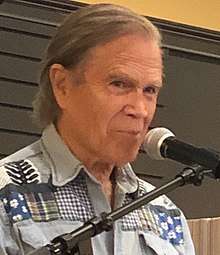Layng Martine Jr.
James Layng Martine Jr. (born 1942), is an American songwriter whose compositions have appeared on the country and pop music charts over a four-decade span beginning the late 1960s. In 2013, he was inducted into the Nashville Songwriters Hall of Fame.[1] Some of Martine's writing credits include Elvis Presley's million-selling "Way Down"; The Pointer Sisters' Top Ten "Should I Do It" and Trisha Yearwood's "I Wanna Go Too Far". He was nominated for a Grammy Award in 1993 for Best Country Song, for co-writing Reba McEntire's "The Greatest Man I Never Knew". Martine's song "Rub It In", a number one country hit for Billy "Crash" Craddock in 1974, became a long-running TV commercial called "Plug It In"[2] for SC Johnson's Glade Plug-ins air freshening product.[3] This song was previously a No. 65 single on the Billboard Hot 100 for Martine himself in 1971, whose version was released on Barnaby Records.[4]
Layng Martine Jr. | |
|---|---|
 | |
| Background information | |
| Birth name | James Layng Martine Jr. |
| Born | 1942 (age 77–78) New York City, New York, U.S. |
| Genres | |
| Occupation(s) | Songwriter, author |
| Instruments | Vocal, guitar |
| Website | layngmartinejr |
Martine authored an article for The New York Times "Modern Love" column about his continued love story with his wife Linda after she became paraplegic in an automobile accident.[5] This article was one of the Times' most-emailed "Modern Love" essays.[6] Martine said that the enormous response to this article was the inspiration for him to write a memoir entitled "Permission to Fly " published in 2019. The book is an inside look at the song-writing side of the music industry.[7]
The couple has three sons, one of whom is musician and producer Tucker Martine.[8]
Early life
Martine Jr. was born in New York City in 1942. The eldest of five children, he grew up in Stamford, Connecticut. His mother wrote for a movie magazine and later a column called "Teen Scene" for Family Circle Magazine; his father sold advertising for a magazine called Babytalk and later worked for Dell Publishing Company.[6] George T. Delacorte Jr., Dell founder, gave young Martine bundles of comic books; while reading those, Martine saw an advertisement for Cloverine Salve and greeting cards and sold these items and others door-to-door.
Martine went to boarding school at Mount Hermon School in northwestern Massachusetts, then on to Denison University, but left school after the first year. Beginning in 1961, he got a job as a copyboy for Time Magazine , then was accepted to Columbia University in New York.[6] While listening to the radio when working one summer as a house painter, Martine became convinced that he could write a song, despite the fact that he had no musical training and did not play any musical instrument. After writing his first song he had the temerity to look up established record publishers in the New York phone book, take a subway from school and present himself unannounced. His song was declined, but executives were helpful in providing advice and other contacts. After college he worked for an advertising firm on Madison Avenue, but in his free time he wrote songs.[6]
Songs written
- "Don't Boogie Woogie When You Say Your Prayers Tonight" – Jerry Lee Lewis, Ray Stevens, Eddy Mitchell
- "Everybody Needs a Rainbow" – Ray Stevens
- "The Greatest Man I Never Knew" – Reba McEntire
- "I Don't Want to Be a One Night Stand" – Reba McEntire
- "I Wanna Go Too Far" – Trisha Yearwood
- "I Was Blown Away" – Pam Tillis
- "Let Me On" – Jerry Lee Lewis, Carl Perkins
- "Maybe She's Human" – Kathy Mattea
- "Rub It In" – Billy "Crash" Craddock[9]
- "Should I Do It" – The Pointer Sisters
- "Too Fast for Rapid City" – Sheila Andrews
- "You Got The Job" – Charly McClain
- "Way Down" – Elvis Presley
References
- "Nashville Songwriters Hall of Fame Inductees". nashvillesongwritersfoundation.com. Retrieved June 10, 2019.
- https://www.youtube.com/watch?v=04z2cBOTdu0
- "Archived copy". Archived from the original on 2011-07-14. Retrieved 2010-11-12.CS1 maint: archived copy as title (link)
- "Chart listing for "Rub It In"". Billboard. Retrieved 2009-02-13.
- Modern Love: In a Charmed Life, a Road Less Traveled NY Times, March 8, 2009
- Martine Jr., Layng (2018). Permission to Fly. Nashville: FieldPoint. ISBN 978-1-7320117-1-7.
- Hance, Mary (May 26, 2019). "Songwriter Layng Martine Jr.'s words move" (Vol.115, No.146). nashvilletennessean-tn.newsmemory.com. The Tennessean. p. C–3. Retrieved May 30, 2019.
- NPR All Songs Considered: Guest DJ Tucker Martine, October 5, 2009
- Layng Martine Jr. – At-large representative Archived 2011-07-14 at the Wayback Machine on Nashville Songwriters Association International website.